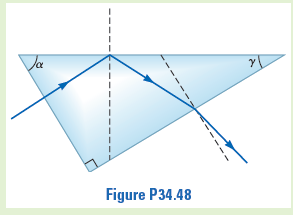Ja Figure P34.48
In your work for an optical research company, you are asked to consider the triangular shaped prism as shown. Light enters the left slanted side of the prism from air at normal incidence, reflects from the top surface by total internal reflection, and then refracts out of the right slanted surface. (a) Your supervisor asks you to determine the range of angles over which visible light exits the right slanted surface due to dispersion in the material. (b) An actual physical prism of the shape as shown is then made from cubic zirconia with α = 60° and γ = 30°, and it doesn’t work as planned. Explain to your supervisor why not.

a)
Let's assume refractive index of the prism is n.
Then critical angle of the prism with respect to air will be
 .......................(1)
.......................(1)
To satisfy the condition of total internal reflection the incident angle of light must be greater than critical angle i.e.
θi>θc. (2)
Incident light can reach the right slanted surface only if it goes total internal reflection therefore equation (2) must be satisfied.
Now let's redraw the given diagram

Given ray R¹ incident normally on surface AB therefore it will get retracted without any deviation.
Therefore line Tm || AC
Therefore
 . (Alternate angle)
. (Alternate angle)
Therefore incident angle at surface BC is
90⁰-γ
But from triangle's angle sum property
α=90⁰-γ
Therefore α is incident angle at point m.
Therefore from equation (2)
α>θc
or using equation (1)

Similarly at the interface AC the incident angle must be less than critical angle so that light can get refracted from the material. From triangle property we can see incident angle is α-γ
Therefore

this is the range of angles over which light can exit from surface AC.
Step by step
Solved in 2 steps with 7 images
